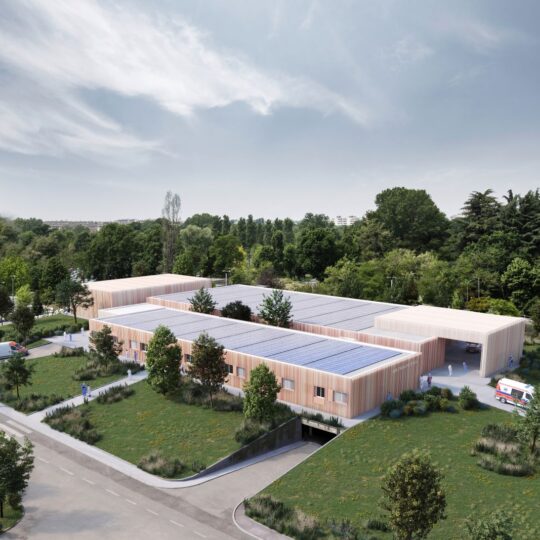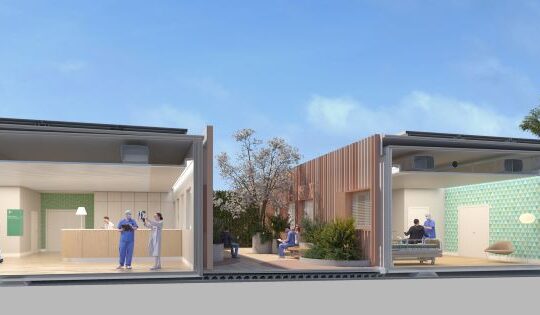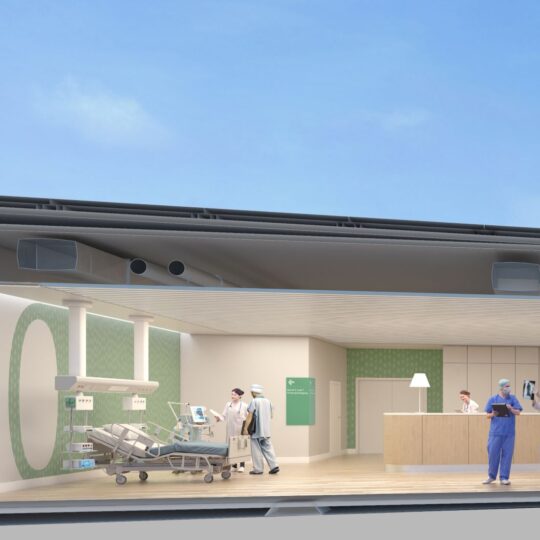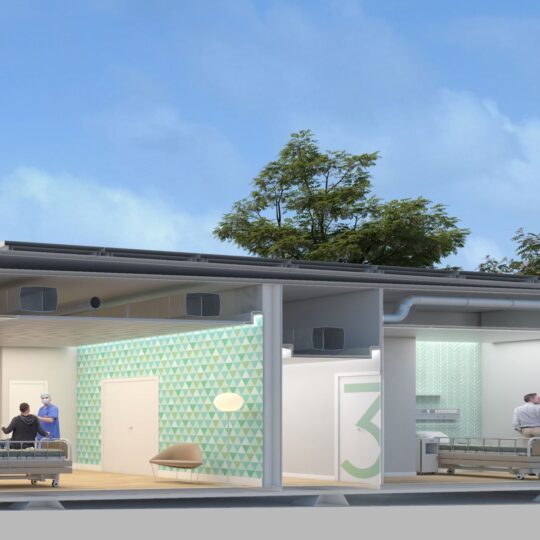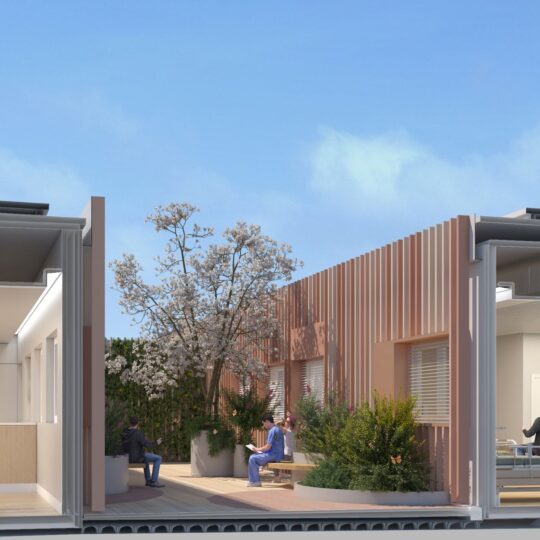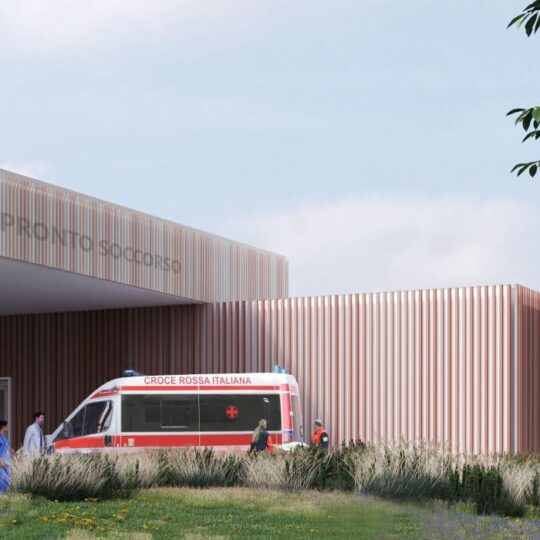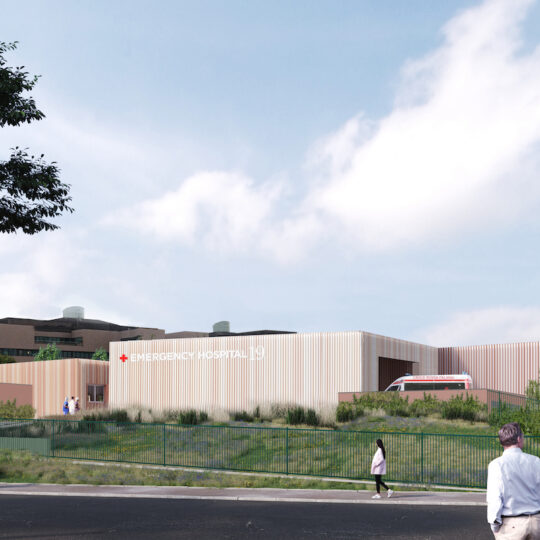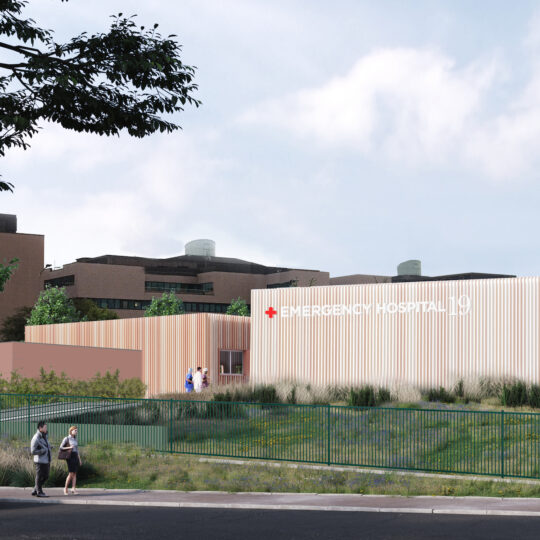A self-sufficient, independent healthcare facility that meets the needs of emergency architecture, but at the same time can become a permanent building: Emergency Hospital 19 is a project developed by Humanitas, with the engineering and design support of Techint and architect Filippo Taidelli for the management and containment of infectious diseases within hospital facilities.
A project in which architecture, medicine and engineering contribute to defining spaces for management and care: efficient, sustainable and with a human face.
Emergency Hospital 19 is the first of three facilities dedicated to emergency carecurrently being built in the North of Italy, Bergamo and Castellanza; it is Humanitas’s response to the need to be ready to manage the critical aspects of an emergency and normal healthcare at the same time: versatile, universally adaptable architecture – achievable in just 3 months – that starting from a modular structure can grow without constraints, be adapted to and integrated with the pre-existing context and have its spaces customised.
The project for Emergency Hospital 19 is based on the need to put man, a patient in today’s hospital, at the centre: the humanisation of the health care environment becomes the means whereby the patient is helped to regain possession of the healing process and the architecture enhances emotional, intellectual and sensorial factors, inserting elements such as family affections, nature and metropolitan stimuli.
Wards and intensive therapy units have large windows that allow the patient to benefit from natural light and a view of the landscape; the rooms are defended against the risk of glaring sun or overheating by the presence of Venetian blinds and silkscreens beyond the window.
In this habitat, the finish of the inner enclosure helps to infuse serenity and tranquillity into the patient: the multicoloured pastel striped wallpaper in rooms and corridors breaks up the monotony and continuity between spaces while the floors, which simulate a seamless wooden deck, and the warm light fixtures (3000 k) also help to create a more enveloping atmosphere.
The relationship with nature and greenery becomes an essential component of architectural design, representing not only an element mitigating the climate of the enclosure, but also a therapeutic tool.
Green areas contribute to mitigating the climate of the enclosure, become an integral part of flow management – in a context where social distancing is a preventive measure – and the patio area, including aromatic plants, perennials and winter flowering shrubs, is the centre around which the operating and inpatient facilities are developed, an area conceived as a small cloister of a Renaissance monastery.
Even inside the hospital, bedridden patients can benefit from the relaxing effect of the vegetation thanks to the presence of plants, shrubs, flowering and aromatic species at the windows, accommodated in coloured flower boxes of different sizes and heights, they make the garden lively even in winter, when there are fewer blooms; consequently, the spontaneous greenery offers an immersive sensory experience without ever disregarding the area’s utmost flexibility, and its maintenance and sanitisation.
Emergency Hospital 19 responds to an extended sustainability principle: technical, social, energetic and environmental; the basic module has been developed to be energetically autonomous, as well as adaptable to latitude and context, and the building enclosure has been designed to reduce incoming thermal energy by up to 50%, thus reducing the energy required by the interior air conditioning.
The more or less breathable double skin allows the building to adapt to different climatic conditions by making the most of the resources available on site to contain energy losses in winter and control overheating in summer.
In temporary and emergency situations, the main purpose of the façade cladding and architectural integration is to combine the necessary modularity of the openings and the repetitiveness of the interior layout with a composition capable of re-establishing a harmonious and flexible relationship with the new urban and landscape context, bringing the hospital conceptually and aesthetically closer to the civic centre.
This is why the external facade of Emergency Hospital 19 has a second modular skin, conceived as a “dress” adaptable to the climatic and image conditions required by the particular geographical context.
The façade also acts as a climate mitigator of the enclosure, to contain solar radiation, increase user comfort and reduce the energy required for the operation of air conditioning systems.
The second skin, consisting of skin and edges, is adaptable to different formal requirements and is a sequence of vertical slats in coloured aluminium which, with the changing point of view, modify the perception of the elevation, creating kinetic effects like those of Rafael Soto’s dynamic installations.
Slat colours can be combined in a variety of percentages on the different facades and in their different formal interpretations the windows are framed by coloured metal soffits that redesign the geometries in large façade-animating parterres; like large lashes, these deep frames protect the glass surface from direct sunlight without limiting transparency, the view on to the surrounding landscape or the patient’s privacy.
Conceived to meet the COVID-19 clinical emergency, the Emergency Hospital 19 presents all the requirements necessary to take on the character of permanence that is crucial to enable it to handle future health emergencies.
The building is configured as a prefabricated, replicable modular system, consisting of six main modules, which correspond to specific internal uses, and other sub-modules that allow an orderly, measured division of space, while encouraging the adoption of prefabricated solutions that can significantly reduce construction times.
Emergency Hospital 19 is therefore a bright proof of the importance of collaboration between architects, engineers and doctors with the aim of imagining and giving life to a new vision of healthcare, more modern, efficient and inclusive.


